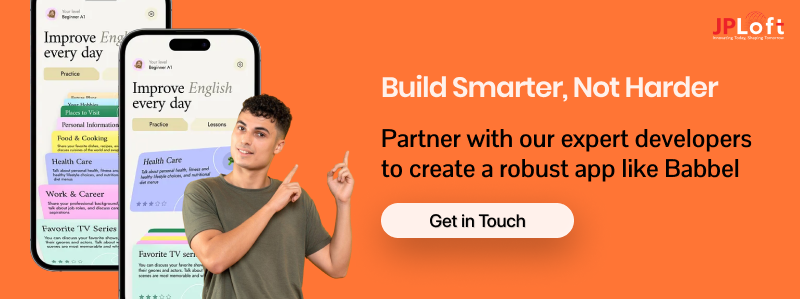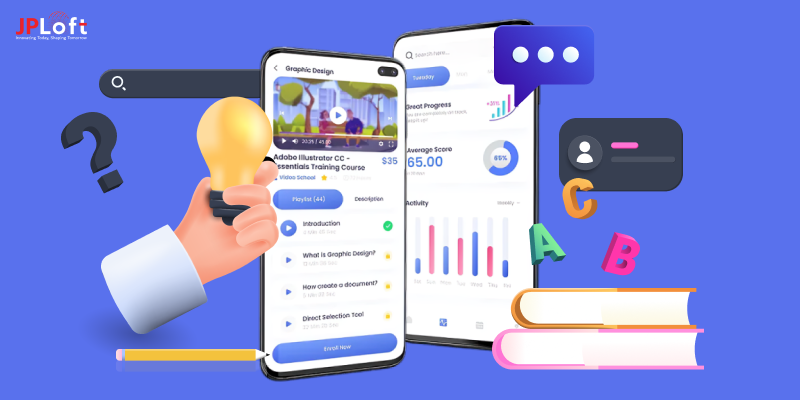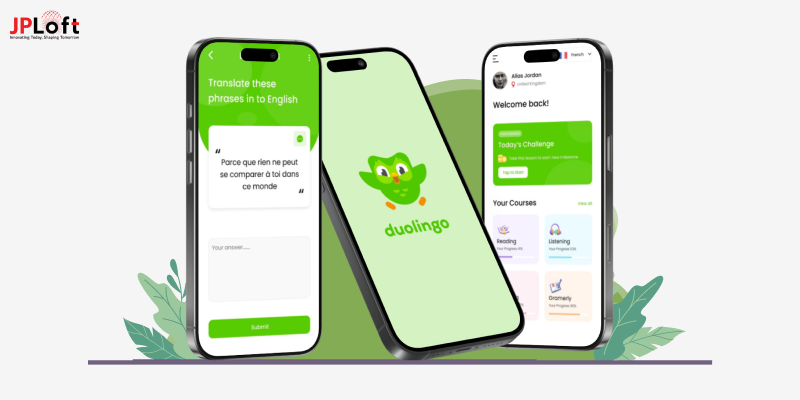Ever thought of launching your own language learning app like Babbel? You’re not alone. With the growing demand for online education, especially language learning, many entrepreneurs and edtech startups are exploring this space.
But one big question always pops up: how much does it cost to create an app like Babbel?
Well, let’s keep it real: building something user-friendly, interactive, and educational doesn’t come cheap, but it’s also not out of reach.
The cost estimation can vary depending on features, design, platform, and team location. On average, the cost to build a language learning app like Babbel ranges between $30,000 to $100,000.
In this blog, we’ll break down everything, from what features to include to where your money actually goes, so you can plan your app idea with clarity and confidence.
What Is Babbel and How Does It Work?
Babbel is one of the most popular language learning apps in the world, designed for people who want to learn a new language at their own pace, anytime, anywhere.
Launched in 2007, Babbel offers courses in more than 14 languages, including Spanish, French, German, Italian, and more. Whether you’re a complete beginner or looking to brush up your skills, Babbel has something for everyone.
But what makes Babbel different from other apps?
Babbel combines real-life conversations with grammar, vocabulary, and pronunciation in a way that’s easy to follow. The lessons are short (usually 10–15 minutes), interactive, and designed by language experts.
Instead of memorizing endless words, users learn through practical dialogues that mimic real-world situations, like ordering food, booking a hotel, or introducing themselves.
Babbel works on a subscription model and is available on both Android and iOS devices, along with a web version. Whether someone is preparing for travel, work, or just learning for fun, Babbel provides a structured yet flexible approach to language learning, one that’s grounded in real-world usage and practical skills.
So, if you're planning to create a mobile app, understanding how Babbel keeps users engaged and delivers value is the first step toward building a successful app.
How Much Does It Cost to Develop an Education App Like Babbel?
If you're planning to build an education app and wondering how much does it cost to develop an app like Babbel, you're not alone.
Many startups and entrepreneurs are inspired by Babbel’s success and want to tap into the growing demand for online language learning. But before diving into development, understanding the cost structure is essential.
On average, the cost to create an app like Babbel ranges between $30,000 to $100,000. This wide range depends on several factors such as app complexity, the number of supported languages, tech stack, and the location of your on-demand app development company.
If you're planning to build an MVP (Minimum Viable Product), you might be able to get started on the lower end. However, a feature-rich app with smart recommendations, gamification, and AI integration will likely land on the higher side.
Whether you're looking for the cost to build an app like Babbel, it's important to define your goals first.
Are you planning to develop a language learning app like Babbel with similar features, or do you have something more customized in mind?
In general, the cost depends on how comprehensive your app is. This includes whether you want offline access, personalized paths, speech recognition, or multilingual support.
In the next section, we will break down the key factors that affect the cost to create an education app like Babbel, helping you better plan your development roadmap.
Key Factors Influencing the Cost to Develop a Language Learning App Like Babbel
If you want to know the cost to develop an app similar to Babbel, it’s important to know there’s no one-size-fits-all answer. The final price depends on multiple factors, from your app’s core features to the development team you hire.
Whether you're looking for the cost to create an app like Babbel breakdown, here are the 10 key factors that directly influence it:
1. App Features & Functionality
The set of education app features you want to include plays a major role in deciding the cost. A basic app might only have login/signup, audio lessons, and quizzes.
But if you're planning to integrate gamification, voice recognition, real-time chat with tutors, or spaced repetition algorithms for personalized learning, the development hours and complexity will increase.
The more interactive and engaging your app is, the more users you’ll attract, but it also means higher investment.
|
Feature |
Description |
Average Development Cost (USD) |
|
User Onboarding |
Simple signup/login via email, phone, or social media. |
$1,500 – $3,000 |
|
Interactive Lessons |
Language modules with exercises, images, and quizzes. |
$6,000 – $10,000 |
|
Speech Recognition |
Helps users improve pronunciation with real-time feedback. |
$8,000 – $12,000 |
|
Progress Tracking |
Visual indicators to show how far users have come in their learning journey. |
$2,500 – $4,000 |
|
Gamification Elements |
Badges, streaks, points, and challenges to make learning fun. |
$3,000 – $5,000 |
|
Offline Mode |
Allows users to download lessons and learn without the internet. |
$4,000 – $6,000 |
|
Push Notifications |
Reminders and motivational nudges to keep users engaged. |
$1,000 – $2,000 |
|
In-App Purchases / Subscriptions |
To monetize through paid lessons, bundles, or premium access. |
$2,000 – $4,000 |
2. Platform Choice (iOS, Android, or Both)
Deciding whether to launch your app on iOS, Android, or both affects the education development cost and timeline.
Native apps for each platform offer better performance but cost more. On the other hand, cross-platform development using frameworks like Flutter or React Native can save on cost and time, but might compromise slightly on user experience.
Either way, this choice directly influences the cost to develop an app like Babbel.
|
Platform |
Description |
Estimated Cost Range |
|
iOS Only |
Access to a premium user base, faster development cycle. |
$15,000 – $25,000 |
|
Android Only |
Broader global reach, especially in developing countries. |
$12,000 – $28,000 |
|
Both Platforms |
Maximum reach across all audiences, ideal for scaling apps. |
$30,000 – $50,000+ |
3. UI/UX Design
An intuitive and visually appealing education app design ensures users stay engaged with your app.
A well-thought-out user journey and smooth navigation are essential for language learning apps, where users often spend hours.
Custom animations, transitions, and interactive interfaces might make your app stand out, but they’ll require extra design time, impacting your Babbel-like app development cost. Great UI/UX is an investment in long-term user retention.
|
Component |
Description |
Estimated Cost (USD) |
|
User Interface Design |
Visually engaging layout, buttons, icons, and a theme that suits learners. |
$3,000 – $5,000 |
|
User Experience Design |
Smooth navigation, intuitive lesson flows, and user-friendly interactions. |
$2,500 – $4,000 |
|
Responsive Design |
Ensures the app works seamlessly across devices and screen sizes. |
$1,500 – $3,000 |
|
Prototype & Wireframes |
Interactive blueprint of screens for initial testing and approvals. |
$1,000 – $2,000 |
4. Backend Development & Database Setup
The backend is the powerhouse of your app. It handles user data, lesson progress, content management, and more.
A scalable and secure backend is essential, especially as your user base grows. Setting up servers, cloud storage, and database architecture takes time and expertise, and will significantly affect the cost to build an education app like Babbel.
|
Component |
Description |
Estimated Cost (USD) |
|
User Management System |
Handles user registration, profiles, and preferences. |
$2,000 – $4,000 |
|
Lesson Data Management |
Organizes language modules, exercises, and tracks progress. |
$3,000 – $6,000 |
|
Database Integration |
Connects the app to a secure and scalable database (e.g., MongoDB, Firebase). |
$2,000 – $3,500 |
|
API Development |
Ensures communication between front-end and back-end functions. |
$3,000 – $5,000 |
|
Security & Authentication |
Protects user data with secure logins and encrypted access. |
$2,000 – $3,000 |
5. Content Creation & Management
Educational content is at the heart of any language learning app. You will need audio lessons, grammar modules, vocabulary quizzes, and interactive exercises.
You can license pre-made content, create it in-house, or partner with language experts. Content curation, categorization, and delivery systems (like CMS) also need to be built and maintained, adding to the cost to develop a language learning app like Babbel.
|
Component |
Description |
Estimated Cost (USD) |
|
Language Lesson Scripts |
Structured content for grammar, vocabulary, and conversational practice. |
$4,000 – $8,000 (per language) |
|
Audio & Voice Recording |
Native speaker recordings for correct pronunciation and listening skills. |
$3,000 – $6,000 |
|
Multimedia Integration |
Images, animations, or videos to support interactive learning. |
$2,000 – $4,000 |
|
Admin Content Panel |
Interface for managing lesson uploads, edits, and updates. |
$2,500 – $4,000 |
6. AI and Personalization Features
Modern users love personalized experiences.
Features like adaptive learning paths, progress tracking, and AI-based suggestions, core elements of AI in education app development, greatly enhance learning outcomes.
However, integrating machine learning models and tracking user behavior requires skilled developers and additional development time. These smart features increase the Babbel-like app development cost, but they’re also key differentiators in the competitive edtech space.
|
Feature |
Description |
Estimated Cost (USD) |
|
Adaptive Learning Paths |
Adjusts lesson difficulty based on user performance and learning speed. |
$4,000 – $7,000 |
|
Speech Recognition |
AI that checks user pronunciation accuracy through voice inputs. |
$5,000 – $8,000 |
|
User Behavior Tracking |
Analyzes user interactions to suggest personalized exercises. |
$2,500 – $4,000 |
|
Progress Prediction Engine |
Estimates user milestones and recommends the next best lessons. |
$3,000 – $5,000 |
7. Third-Party Integrations
You will likely need several third-party APIs to enhance functionality, such as payment gateways, speech recognition, live chat support, push notifications, and analytics.
Some of these come with monthly fees, while others add to development time. The more integrations you include, the higher the cost to build an app like Babbel but they also improve usability and engagement.
|
Integration |
Description |
Estimated Cost (USD) |
|
Payment Gateway |
Allows users to subscribe or purchase lessons via Stripe, PayPal, etc. |
$2,000 – $3,500 |
|
Social Login Integration |
Enables login/sign-up using Google, Facebook, or Apple accounts. |
$1,000 – $2,000 |
|
CRM & Analytics Tools |
Connects to tools like Google Analytics, Mixpanel, or HubSpot for insights. |
$1,500 – $3,000 |
|
Email & Push Notifications |
Integrates with services like Firebase or OneSignal for timely updates. |
$1,000 – $2,000 |
8. Team Location and Expertise
The cost to develop an education app like Babbel depends heavily on who you hire.
If you hire dedicated developers in Australia, the US, or the UK may charge $100–$200/hour, while developers in India or Eastern Europe may charge $25–$50/hour.
However, cheaper doesn’t always mean better. Look for teams with experience in building e-learning or language apps. A skilled team gets the job done faster and more efficiently.
|
Location |
Hourly Rate (USD) |
Average Cost |
|
USA / Canada |
$80 – $150/hr |
$50,000 – $150,000+ |
|
Eastern Europe |
$40 – $70/hr |
$40,000 – $100,000 |
|
India / Asia |
$20 – $40/hr |
$20,000 – $80,000 |
|
Mixed Team |
Varies |
$30,000 – $120,000 |
9. Testing and QA
Language apps often deal with large amounts of content and user interactions. Thorough app testing ensures your app is stable, bug-free, and performs well on all devices.
Manual and automated QA is essential before launching. While this adds to the Babbel clone app development cost, it also reduces user complaints and improves ratings.
|
Activity |
Description |
Estimated Cost (USD) |
|
Functional Testing |
Ensures all features work correctly as intended. |
$2,000 – $3,000 |
|
UI/UX Testing |
Checks that the interface is user-friendly and consistent across devices. |
$1,500 – $2,500 |
|
Performance Testing |
Tests how the app performs under various conditions (speed, load, etc.). |
$2,000 – $3,500 |
|
Security Testing |
Identifies vulnerabilities to protect user data and app integrity. |
$2,000 – $4,000 |
|
Cross-platform Testing |
Make sure the app runs smoothly on different devices and OS versions. |
$1,500 – $3,000 |
|
Bug Fixing & Regression |
Ongoing fixes and retesting of previously working features after updates. |
$1,000 – $2,000 |
10. Maintenance & Updates
Once your app is live, you’ll need regular updates to fix bugs, improve features, and introduce new languages or content.
You’ll also need to keep up with OS updates and new devices. Budgeting for post-launch support is essential for any successful app. Ongoing app maintenance services are a crucial part of the cost to create a language learning app like Babbel.
|
Activity |
Description |
Estimated Cost (USD/month) |
|
Regular Bug Fixes |
Fixes small issues or glitches reported by users post-launch. |
$500 – $1,000 |
|
OS & Device Updates |
Ensures compatibility with the latest iOS/Android versions. |
$500 – $1,500 |
|
Feature Enhancements |
Minor improvements to existing features based on user feedback. |
$1,000 – $2,000 |
|
Server & Hosting Support |
Managing uptime, storage, bandwidth, and cloud hosting services. |
$300 – $700 |
|
User Support & Monitoring |
Handles technical support, reviews, crash logs, and app performance metrics. |
$500 – $1,000 |
Now that you understand the various elements that shape the cost to develop language learning apps Babbel, it’s just as important to know how to reduce the cost.
Smart Tips to Reduce the Cost of Developing a Babbel-like App
Building a language learning app like Duolingo or Babbel can feel like a big investment especially when you see it can cost up to $100,00 or more. But here’s the good news: there are smart ways to cut down the cost without cutting corners.
Let’s explore some practical tips that can help you build a powerful app while staying within budget.
1] Start with an MVP (Minimum Viable Product)
Don’t try to launch with every feature Babbel has. Instead, build a basic version with only the core features like lesson modules, user login, and progress tracking.
Once your MVP is live and gets user feedback, you can expand features gradually. This approach saves money upfront and gives you a better understanding of what your users really want.
2] Use Ready-Made Solutions When Possible
Instead of developing everything from scratch, use pre-built templates, UI kits, or open-source tools for features like sign-up, subscriptions, or video playback. These tools can significantly speed up development and reduce your costs.
3] Outsource to Experienced Yet Affordable Teams
Hiring the best mobile app development company from regions like India or Eastern Europe can give you high-quality work at much lower rates compared to the US or Australia. Just make sure they have experience in developing mobile apps and a strong portfolio.
4] Prioritize Features Based on User Value
Not every cool idea is essential in version one. Focus on features that directly improve the user learning experience, like progress tracking, simple gamification, or audio lessons. Leave complex AI or AR integrations for future updates.
5] Automate Content Management
Instead of manually uploading and managing lessons, ask your developers to create a simple backend system where your team can add, edit, and organize content easily.
This reduces ongoing dependency on tech teams and saves long-term maintenance costs.
6] Regular Testing During Development
Fixing bugs post-launch is always more expensive. Regular testing during development helps catch issues early, which is not only cheaper but also improves the overall quality of your app.
With these smart tips, you can lower your mobile app development cost while still delivering a high-quality, engaging language learning experience.
Now, in the next section explore how to make money. After all, well-planned monetization strategies are key to making your investment worthwhile.
How Do Language Learning Apps Like Babbel Make Money?
If you’re planning to develop a language learning app like Babbel, understanding how it generates revenue is just as important as building great features.
After all, even the best language learning apps need a solid income stream to stay alive and grow. So, how do apps like Babbel earn their profits?
Let’s break it down.
1. Subscription-Based Model
This primary revenue source for apps like Babbel.
Users pay for a monthly, quarterly, or annual plan to access language lessons. The content is often locked behind a paywall, encouraging users to subscribe to unlock advanced features and complete course access. This model ensures steady, recurring revenue.
2. Freemium Model
Babbel-like apps give new users a taste of what the platform offers, basic lessons, or limited content for free. Once users are engaged, they’re nudged to upgrade for the full experience.
This “try before you buy” method is very effective in increasing conversions and growing the user base.
3. Corporate Licensing
Another growing trend is licensing the app to businesses and institutions.
Many companies invest in language learning tools for their employees to support global collaboration. Babbel for Business is an example where they offer packages for teams and organizations, opening up business models.
4. Affiliate Marketing & Partnerships
While not a core model, apps like Babbel can also earn from promoting language-related services or tools, like travel apps, dictionaries, or online tutoring platforms. These partnerships can offer commission-based earnings or flat promotional fees.
5. In-App Purchases (Add-ons)
Some language learning apps like Babbel also offer paid add-ons such as advanced grammar packs, live tutor sessions, or cultural modules. These optional purchases can significantly boost the average revenue per user.
Understanding how apps like Babbel generate income is just one part of the puzzle, knowing how to manage your development budget smartly is equally important.
So, before you start building, take a look at these smart tips to reduce the cost of developing a Babbel-like app.
Why is JPLoft the Right Partner to Build Your Babbel-like Language Learning App?
Building a successful language learning app like Babbel isn’t just about having a great idea, it’s about partnering with the right education app development company that understands the tech, the trends, and your vision. That’s where JPLoft comes in.
At JPLoft, we specialize in crafting high-performing, scalable, and user-friendly education and e-learning apps tailored for both startups and enterprises.
Whether you’re looking to build a feature-rich Babbel clone or a unique solution with AI-based personalization, our team brings the technical expertise and market insights you need.
Ready to create your own language learning app like Babbel or Duolingo? Get in touch with JPLoft for smart, future-ready solutions.
The Bottom Line
In conclusion, building a language learning app like Babbel requires careful planning, budgeting, and the right development team.
Whether you’re focusing on core features or integrating AI-driven personalization, every decision impacts the overall cost to develop an app like Babbel.
On average, the Babbel-like app development cost can range between $30,000 to $100,000, depending on factors like platform, location, and functionality.
If you’re aiming to create a language learning app like Babbel, it’s essential to work with an experienced team. A clear roadmap, smart planning, and reliable partners can help you develop a feature-rich, cost-effective app that stands out in the growing edtech market.
FAQs
The cost to develop an app like Babbel typically ranges between $30,000 to $100,000, depending on features, platforms, design complexity, and the location of your development team.
Yes! You can reduce costs by starting with an MVP, using pre-built modules, outsourcing to regions with lower rates (like India), and prioritizing core features first.
Apps like Babbel earn revenue through subscription models, freemium plans, in-app purchases, and even B2B partnerships with schools and corporates.
Depending on the complexity, it can take 3 to 9 months. This includes planning, design, development, testing, and launch.
Yes, integrating AI for personalized lessons, speech correction, and user behavior analysis enhances learning and app engagement, though it will slightly increase development costs.














Share this blog